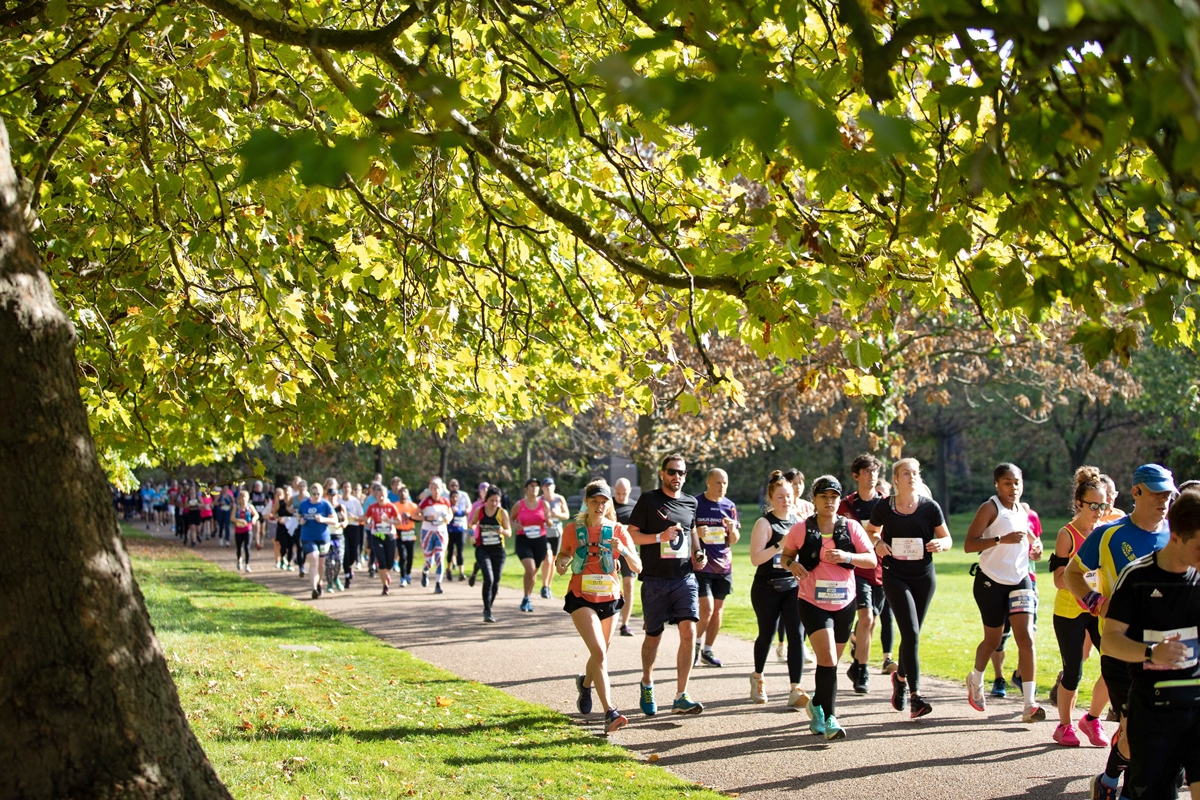Home>Misc>Featured>Why Do Runners Breathe Heavily After A Sprint Race


Featured
Why Do Runners Breathe Heavily After A Sprint Race
Modified: January 2, 2024
Discover why featured runners often breathe heavily after a sprint race and the reasons behind this intense exertion. Exploring the effects of intense exercise on the respiratory system.
Introduction
Sprint racing is an exhilarating and demanding sport that pushes athletes to their physical limits. Whether it’s a short-distance sprint on the track or a high-intensity interval training (HIIT) session, runners often find themselves breathing heavily after a race. This noticeable change in breathing patterns is a result of various factors that come into play during sprint racing.
Breathing, a vital function of our body, becomes even more crucial during intense physical activities like sprinting. It facilitates the exchange of oxygen and carbon dioxide, supplying the working muscles with the necessary oxygen while removing waste gases. The efficiency of breathing can greatly impact an athlete’s performance and recovery.
In this article, we will delve into the reasons why runners breathe heavily after a sprint race. We will explore the physiological factors that contribute to increased breathing during sprinting and discuss the importance of efficient breathing techniques for optimal performance.
Understanding the mechanics of breathing during sprint racing can help athletes and coaches develop strategies to improve their breathing efficiency, enhance performance, and accelerate recovery. So, let’s dive into the factors that influence heavy breathing during sprint races.
Factors affecting breathing during sprint racing
When sprinting at high speeds, the body undergoes several physiological changes that directly impact breathing. Let’s explore the key factors that contribute to heavy breathing during sprint racing.
- Increased oxygen demand: During a sprint race, the body requires a significant amount of oxygen to meet high energy demands. Muscles need oxygen to fuel their contractions and generate the necessary force for quick acceleration. This increased demand for oxygen triggers a physiological response, resulting in heavy breathing.
- Elevated heart rate: Sprint racing places a substantial demand on the cardiovascular system. As the intensity of the race increases, the heart rate rises to supply oxygen-rich blood to the working muscles. The elevated heart rate not only ensures an adequate oxygen supply but also helps remove waste products, such as carbon dioxide, from the body.
- Increased carbon dioxide production: As muscles work harder during sprint racing, they produce more carbon dioxide as a byproduct of cellular metabolism. The buildup of carbon dioxide triggers the body’s response to eliminate it, leading to increased breathing to expel carbon dioxide and maintain the oxygen-carbon dioxide balance.
- Activation of the sympathetic nervous system: During intense physical activity, the sympathetic nervous system responds by releasing epinephrine and norepinephrine, commonly known as adrenaline. These neurotransmitters enhance respiratory function, increasing heart rate and breathing rate to meet the heightened oxygen demands.
- Increased respiratory rate: To keep up with the oxygen demands during sprint racing, the respiratory system adapts by increasing the respiratory rate. This allows for a higher volume of air exchange in the lungs, ensuring a steady supply of oxygen for the working muscles and efficient removal of carbon dioxide.
These factors collectively contribute to heavy breathing during sprint racing. The body’s physiological responses are finely tuned to optimize performance and maintain a delicate balance between oxygen supply and carbon dioxide removal.
Increased oxygen demand
One of the primary reasons runners breathe heavily after a sprint race is the increased oxygen demand. During sprinting, the muscles in the body require a substantial amount of oxygen to produce the energy needed for fast and powerful movements.
When we engage in high-intensity exercise, our bodies rely on anaerobic metabolism, which doesn’t require oxygen, to fuel the initial burst of energy. However, as the intensity and duration of the sprint increase, our bodies transition to aerobic metabolism, which relies on oxygen to generate energy. This shift to aerobic metabolism significantly increases the demand for oxygen.
To meet this increased demand, our respiratory system responds by increasing the rate and depth of breathing. The lungs take in a larger volume of air, enabling more oxygen to be transported to the bloodstream. The oxygen-rich blood is then delivered to the working muscles, where it is used to break down glucose and produce adenosine triphosphate (ATP), the primary energy source for muscle contractions.
This elevated oxygen demand not only supports muscle contraction but also serves other vital functions during sprinting. Oxygen is necessary for oxidative phosphorylation, a process that helps in the efficient extraction of energy from glucose. It also aids in the removal of waste products, such as lactic acid, which can accumulate in the muscles during intense exercise.
Furthermore, increased oxygen supply promotes the delivery of nutrients and the removal of metabolic waste from the working muscles. This helps to prevent muscle fatigue and supports the overall performance during a sprint race.
It’s important to note that the body’s ability to meet this increased oxygen demand is influenced by various factors, such as cardiovascular fitness, lung capacity, and aerobic conditioning. Athletes with higher aerobic fitness levels often have more efficient oxygen utilization and may experience less heavy breathing during sprint races compared to those who are less conditioned.
Elevated heart rate
Another factor that contributes to heavy breathing after a sprint race is the elevated heart rate. The heart plays a crucial role in supplying oxygen-rich blood to the working muscles and removing waste products, such as carbon dioxide.
During sprinting, the body requires a rapid and efficient transportation system to deliver oxygen to the muscles. To meet this demand, the heart rate increases significantly. The heart pumps faster and harder to circulate a greater volume of blood, ensuring an adequate oxygen supply to the working muscles.
As the heart rate rises, it prompts the smooth muscles lining the walls of the blood vessels to dilate, allowing for increased blood flow. This vasodilation facilitates the delivery of oxygenated blood and nutrients to the muscles while aiding in the removal of waste products.
The elevated heart rate during a sprint race is triggered by the body’s response to the increased workload. The sympathetic nervous system releases stress hormones, such as adrenaline, which stimulate the heart to beat faster and stronger. This phenomenon is often referred to as the “fight or flight” response.
The increased heart rate not only ensures an adequate oxygen supply but also helps to expel carbon dioxide and other waste gases. As the muscles work harder during sprinting, they produce more carbon dioxide as a byproduct of cellular metabolism. The elevated heart rate promotes greater blood flow to the lungs, where carbon dioxide is exchanged for oxygen, facilitating efficient gas exchange.
In addition to facilitating the delivery of oxygen and the removal of waste products, an elevated heart rate also plays a role in maintaining body temperature. During sprinting, the increase in muscular activity generates heat. The heart rate plays a part in distributing this heat throughout the body, allowing for effective thermoregulation.
The ability to maintain an elevated heart rate during a sprint race is influenced by factors such as cardiovascular fitness, training, and genetics. Regular endurance training can improve the heart’s efficiency, resulting in a lower resting heart rate and a more adaptive response to intense exercise.
Increased carbon dioxide production
During a sprint race, the working muscles produce more carbon dioxide as a byproduct of cellular metabolism. This increased carbon dioxide production contributes to heavy breathing as the body works to eliminate the excess gas.
As the intensity of the sprint increases, the muscles require a higher energy output. They rely on the breakdown of glucose through anaerobic metabolism, which produces lactate and hydrogen ions. These byproducts are then converted into carbon dioxide and water through various metabolic pathways.
The buildup of carbon dioxide triggers the body’s response to remove it. The elevated concentration of carbon dioxide in the blood stimulates the respiratory centers in the brain, leading to an increase in breathing rate and depth. This allows for more efficient gas exchange in the lungs, enabling the elimination of carbon dioxide and the intake of oxygen.
The elimination of carbon dioxide is essential for maintaining proper pH balance in the body. High levels of carbon dioxide lead to a decrease in blood pH, resulting in acidosis. The body’s increased breathing rate helps to regulate blood pH by expelling excess carbon dioxide and restoring a balance between acid and base levels.
It is important to note that the increased carbon dioxide production is also closely related to the activation of anaerobic metabolism during intense exercise. As the body’s demand for energy exceeds the capacity of aerobic metabolism, a higher proportion of glucose is broken down without oxygen, producing more carbon dioxide as a result.
Furthermore, the removal of carbon dioxide allows for efficient oxygen uptake in the lungs. By eliminating the waste gas, the body can maintain a healthy oxygen-to-carbon-dioxide ratio, ensuring an adequate supply of oxygen to the working muscles.
The ability to efficiently regulate carbon dioxide levels during a sprint race is influenced by factors such as cardiovascular fitness, lung capacity, and efficiency of the respiratory system. Regular training and proper breathing techniques can help athletes optimize their breathing and enhance carbon dioxide elimination, supporting their performance and recovery.
Activation of the sympathetic nervous system
In the midst of a sprint race, the body undergoes a surge of adrenaline and activates the sympathetic nervous system. This activation contributes to heavy breathing as part of the body’s response to intense physical exertion.
The sympathetic nervous system is responsible for triggering the “fight or flight” response in the body. It releases stress hormones, such as adrenaline and norepinephrine, into the bloodstream. These hormones have various effects on the body, including increased heart rate, dilation of blood vessels, and heightened respiratory function.
As the sympathetic nervous system is activated during a sprint race, it stimulates the heart to beat faster and stronger. This increased heart rate allows for a greater volume of blood to be pumped to the working muscles, delivering oxygen-rich blood and removing waste products.
In addition to the cardiovascular response, the activation of the sympathetic nervous system enhances respiratory function. Adrenaline stimulates the respiratory centers in the brain, leading to an increase in breathing rate and depth. This helps to supply the working muscles with a higher volume of oxygen while facilitating the removal of carbon dioxide.
The heightened respiratory function brought about by the activation of the sympathetic nervous system supports the increased oxygen demand during a sprint race. It ensures a continuous flow of oxygen to the muscles, maximizing performance and energy production.
Furthermore, the sympathetic nervous system activation also promotes bronchodilation, a process that widens the airways in the lungs. This allows for increased airflow and improved oxygen uptake during intense exercise. By opening up the air passages, the body can maximize oxygen delivery and enhance respiratory efficiency.
It is important to note that the activation of the sympathetic nervous system is a natural physiological response to the demands of sprint racing. However, individual responses may vary based on factors such as fitness level, training, and genetics. Athletes with higher aerobic fitness levels may have a more efficient sympathetic response and experience less pronounced heavy breathing during a sprint race.
Increased respiratory rate
During a sprint race, one of the noticeable changes in breathing is an increased respiratory rate. The body responds to the increased demand for oxygen by adjusting the rate of breathing to ensure an adequate supply of oxygen to the working muscles.
The respiratory rate refers to the number of breaths taken per minute. During intense exercise like sprinting, the respiratory rate rises significantly to meet the increased oxygen demand. This increase in respiratory rate allows for a larger volume of air exchange in the lungs, enhancing oxygen uptake and carbon dioxide removal.
The primary muscles involved in breathing, such as the diaphragm and intercostal muscles, work harder as the respiratory rate increases. These muscles contract and relax with greater intensity, expanding the chest cavity and drawing in more air.
By increasing the respiratory rate, the body can meet the oxygen demands of the muscles more efficiently. It promotes a steady flow of oxygenated air into the lungs and allows for the removal of waste gases, such as carbon dioxide, to support proper gas exchange.
In addition to facilitating oxygen uptake and carbon dioxide elimination, an increased respiratory rate also aids in maintaining acid-base balance. During intense exercise, lactic acid can accumulate in the muscles, leading to a decrease in blood pH. By increasing the respiratory rate, the body helps eliminate excess carbon dioxide, which helps regulate the pH and prevent acidification of the blood.
It is important to note that individuals may have different baseline respiratory rates and responses to increased exercise intensity. Factors such as fitness level, lung capacity, and training can influence one’s ability to adapt and efficiently increase the respiratory rate during a sprint race.
Proper breathing techniques and training can also play a significant role in optimizing respiratory efficiency during a sprint race. By focusing on controlled and deep breaths, athletes can enhance oxygen uptake and minimize oxygen wastage, ultimately improving performance and reducing post-race heavy breathing.
Role of lactic acid
Lactic acid, also known as lactate, plays a significant role in the body’s response to intense exercise like sprint racing. As the muscles work harder during a race, they produce lactic acid as a byproduct of anaerobic metabolism.
During high-intensity exercise, the demand for energy exceeds the capacity of aerobic metabolism. To compensate, the body relies on anaerobic metabolism, which breaks down glucose without the need for oxygen. This process produces lactate as a byproduct.
Contrary to popular belief, lactic acid itself does not cause muscle fatigue or soreness. In fact, lactate serves as an essential fuel for other metabolic processes. It can be utilized by other muscles, converted back into glucose in the liver (gluconeogenesis), or used for energy by the heart and brain.
However, the accumulation of lactate in the muscles during intense exercise can lead to a decrease in pH, causing the muscles to become acidic. This increase in acidity interferes with muscle contraction and can contribute to muscle fatigue and a burning sensation during a sprint race.
Heavy breathing after a sprint race is, in part, a mechanism to remove and metabolize lactic acid. As the respiratory rate increases, more oxygen is delivered to the muscles, aiding in the breakdown of lactate. Additionally, the removal of carbon dioxide through increased breathing helps regulate the pH balance in the muscles and restores optimal functioning.
The ability to efficiently metabolize lactic acid can vary among individuals. Well-trained athletes often have a higher lactate threshold, meaning their muscles can tolerate and clear lactate more effectively. This allows them to perform at higher intensities for longer durations without experiencing excessive buildup of lactic acid.
Training adaptations, such as endurance exercises and interval training, can enhance the body’s ability to clear lactate efficiently. These adaptations include increased capillary density, improved oxygen utilization, and enhanced buffering capacity to neutralize the acidic environment in the muscles.
Overall, while lactic acid is often associated with muscle fatigue, it serves as an important metabolic fuel and stimulus for training adaptations. The body’s response to lactic acid accumulation during sprint racing leads to increased breathing and improved lactate clearance, enabling athletes to perform at their best and recover efficiently.
Recovery process
After a sprint race, the body undergoes a recovery process to restore its physiological systems and recover from the intense exertion. This recovery process is crucial for optimizing performance in subsequent races and allowing the body to adapt to the stress of sprinting.
One of the key aspects of post-race recovery is the restoration of normal breathing patterns. After a sprint race, the respiratory system gradually returns to a resting state. The breathing rate and depth gradually decrease as the body’s oxygen demands decrease. However, heavy breathing may persist for a short period as the body continues to remove excess carbon dioxide and restore normal pH levels.
The recovery process also involves cardiovascular adjustments. The heart rate gradually decreases as the body’s demand for oxygen decreases. Blood vessels that dilated during the race start to constrict, returning to their normal state. These cardiovascular adjustments help regulate blood pressure and ensure adequate blood flow to the muscles and organs.
Muscle recovery is another crucial component of the recovery process. After intense exercise like sprinting, muscles may experience micro-tears and a buildup of metabolic waste products. The body repairs these micro-tears and removes waste products through processes such as protein synthesis and increased blood flow to the muscles.
Nutrition plays a vital role in the recovery process. Consuming an appropriate post-race meal or snack within the first hour after a sprint race helps replenish glycogen stores, facilitate muscle repair, and support overall recovery. Adequate hydration is also crucial to restore fluid balance and support optimal physiological function.
Rest and sleep are essential components of the recovery process. Athletes need sufficient time to allow their bodies to repair and adapt to the stress of sprinting. Quality sleep promotes tissue repair, hormone regulation, and overall recovery.
In addition to physical recovery, mental and emotional recovery are also important. Sprint racing can be mentally and emotionally demanding, and athletes may experience a range of emotions after a race. To support mental and emotional recovery, athletes can engage in techniques such as relaxation exercises, mindfulness, and seeking support from coaches or sports psychologists.
The duration of the recovery process can vary depending on factors such as individual fitness levels, race intensity, and training background. Incorporating appropriate recovery strategies, such as active rest, foam rolling, and gentle stretching, can help facilitate the recovery process and prepare athletes for future races.
By allowing the body to recover effectively, athletes can optimize their performance, reduce the risk of injury, and maintain long-term success in sprint racing.
Strategies to improve breathing efficiency during sprint racing
Improving breathing efficiency is crucial for maximizing performance and endurance during a sprint race. Here are some strategies that can help optimize breathing during sprint racing:
- Focus on breathing technique: Proper breathing technique can enhance oxygen uptake and minimize wasted energy. It’s important to focus on taking deep breaths, utilizing the diaphragm, and exhaling fully. Practice rhythmic breathing patterns that coincide with your running stride to establish an efficient breathing rhythm.
- Strengthen respiratory muscles: Engaging in specific exercises to strengthen respiratory muscles, such as the diaphragm and intercostal muscles, can enhance breathing capacity and endurance. Incorporate exercises like deep breathing exercises, diaphragmatic breathing, and spirometry into your training routine to improve respiratory muscle strength.
- Improve cardiovascular fitness: Enhancing cardiovascular fitness through regular endurance training can improve the efficiency of the cardiovascular and respiratory systems. Engage in aerobic activities such as running, cycling, or swimming to increase lung capacity, improve oxygen utilization, and enhance overall endurance.
- Practice breath control: Breath control exercises, such as breath holds and patterned breathing, can help train your body to manage oxygen and carbon dioxide levels more effectively. These exercises can improve breath control, reduce anxiety, and enhance focus during intense racing conditions.
- Utilize altitude training: Training at high altitudes or using altitude simulation techniques can improve respiratory efficiency. The lower oxygen levels at higher altitudes force the body to adapt, increasing red blood cell production and improving the body’s ability to deliver and utilize oxygen during races at lower altitudes.
- Maintain proper posture: Good posture can optimize lung capacity and breathing mechanics. Stand tall, engage your core, and ensure your shoulders are relaxed and not hunched forward. Maintaining correct posture while running allows for better air intake and helps prevent unnecessary tension in the respiratory muscles.
- Manage stress and anxiety: Psychological factors can impact breathing efficiency during sprint racing. Incorporate relaxation techniques such as meditation, visualization, and deep breathing exercises to manage stress and anxiety. This can help maintain calmness, optimize breathing, and improve overall performance.
It’s important to note that these strategies should be incorporated gradually into your training routine to allow the body to adapt. Experiment with different techniques and find what works best for you in terms of breathing efficiency and performance improvement.
By implementing these strategies and making breathing efficiency a priority in your training, you can optimize your respiratory function and enhance your sprint racing performance.
Conclusion
Understanding the factors that contribute to heavy breathing during sprint racing is essential for athletes looking to optimize their performance. Increased oxygen demand, elevated heart rate, increased carbon dioxide production, activation of the sympathetic nervous system, and increased respiratory rate are all key factors that play a role in heavy breathing during a sprint race.
The body’s response to sprint racing is a complex and coordinated effort to meet the increased energy demands of the working muscles. The respiratory system, cardiovascular system, and nervous system all work together to provide oxygen to the muscles, remove waste gases, and support overall performance.
Improving breathing efficiency during sprint racing can be achieved through strategies such as focusing on breathing technique, strengthening respiratory muscles, improving cardiovascular fitness, practicing breath control, utilizing altitude training, maintaining proper posture, and managing stress and anxiety. These strategies help athletes optimize their respiratory function, enhance oxygen uptake, and minimize energy wastage, ultimately improving performance and endurance.
The recovery process after a sprint race is also crucial for allowing the body to restore its physiological systems and adapt to the stress of sprinting. Adequate rest, nutrition, and hydration are important components of the recovery process, along with mental and emotional recovery.
By understanding and implementing these strategies, athletes can optimize their breathing efficiency, enhance their performance, and accelerate their recovery after a sprint race. Balancing training, rest, and proper breathing techniques will help athletes reach their full potential in the exciting and demanding world of sprint racing.









